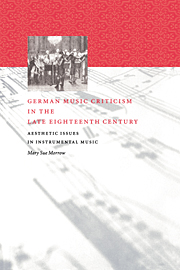Book contents
- Frontmatter
- Contents
- Acknowledgments
- Author's note
- Introduction: terms of discourse
- 1 What does instrumental music mean?
- 2 Answering with a unified voice
- 3 Answering with a German voice
- 4 Answering with aesthetic criteria
- 5 The importance of being correct
- 6 The reign of genius
- 7 A call to order
- 8 Epilogue: segue to the nineteenth century
- Notes
- Bibliography
- Index
8 - Epilogue: segue to the nineteenth century
Published online by Cambridge University Press: 03 October 2009
- Frontmatter
- Contents
- Acknowledgments
- Author's note
- Introduction: terms of discourse
- 1 What does instrumental music mean?
- 2 Answering with a unified voice
- 3 Answering with a German voice
- 4 Answering with aesthetic criteria
- 5 The importance of being correct
- 6 The reign of genius
- 7 A call to order
- 8 Epilogue: segue to the nineteenth century
- Notes
- Bibliography
- Index
Summary
By 1799, when Tieck and Wackenroder's essays began the chain of aesthetic events that secured the aesthetic value of abstract, non-mimetic instrumental music, the German-speaking public had already had forty years to get used to the idea. In the same way that an advertising slogan can insinuate an underlying message into the public consciousness much more effectively than a learned essay on consumer trends, the review collective had continuously hammered home the idea of an instrumental music that could and should be judged on its own terms. That task had been accomplished by 1798, the cutoff point for this study. I did not, however, choose that date simply to provide a tidy package of concepts neatly wrapped up before the publications of Tieck and Wackenroder in 1799; other signs indicate that the collective itself had approached a significant juncture in its development.
For one thing, it had begun to shrink. Only a single new non-music periodical joined its ranks in the 1790s (and it provided only one review), a slump that contrasted markedly with the activity of the previous twenty years (see table 7.1). In the early part of the decade, many scholarly review journals began to curtail their music reviewing; beginning in 1795, the number of instrumental reviews fell precipitously, dropping from a total of 353 during the period from 1790 to 1794 down to only 28 between 1795 and 1798 (see table 8.1). Some of the suddenness resulted from the near total absence of music magazines in those years.
- Type
- Chapter
- Information
- German Music Criticism in the Late Eighteenth CenturyAesthetic Issues in Instrumental Music, pp. 151 - 157Publisher: Cambridge University PressPrint publication year: 1997

